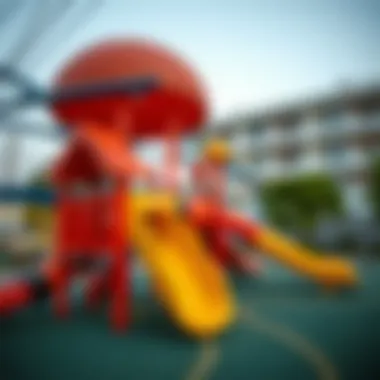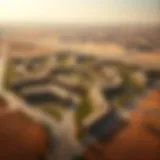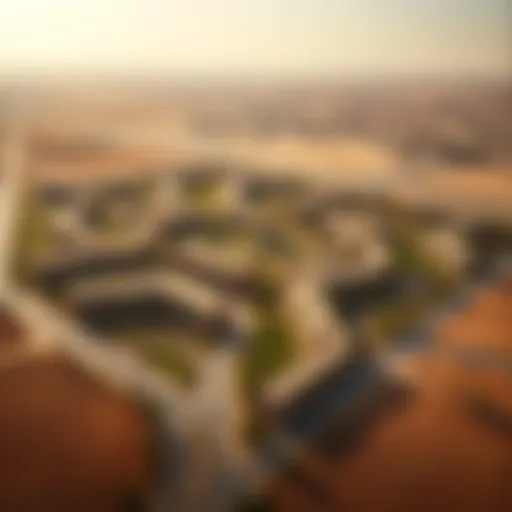Play Areas in Dubai: Enhancing Community Life


Intro
In the hustle and bustle of urban life, the notion of play often takes a backseat, especially in the concrete jungles of rapidly growing cities like Dubai. Yet, play areas in residential developments have emerged as essential components, serving not just as spaces for recreation, but also as vital elements that enhance the quality of life. As developers and planners shift their focus towards cultivating environments that foster community interaction, the presence of well-designed play areas becomes increasingly significant.
This article serves as a comprehensive guide to understanding the multilayered aspects of play areas within residential developments in Dubai. It spans a variety of topics, from the aesthetic and functional considerations in design to safety standards, trends, and community engagement. Moreover, for investors and property seekers, this document offers insights into the ROI of investing in residential properties that integrate thoughtfully designed play spaces. Through a thorough examination, the article ultimately aims to underscore the irreplaceable role that play areas play in nurturing vibrant communities.
Market Trends and Insights
Current Market Conditions
The residential real estate market in Dubai has seen a notable transformation in recent years. The emphasis on building family-friendly environments is reshaping how properties are designed and marketed. Developers are increasingly incorporating playful spaces to attract families, acknowledging that these elements are not merely enhancements but necessities. This shift reflects the growing public awareness and demand for holistic living environments, where play areas are deemed critical for community well-being.
Research reveals that communities boasting quality play areas often see increased property values and stronger neighborhood cohesion. As families settle into these areas, their participation in community life tends to improve, which in turn elevates the appeal of properties.
Future Predictions and Projections
As we look towards the future, several trends are expected to shape the landscape of play areas in residential developments. Firstly, the incorporation of technology is anticipated to rise. Smart play areas equipped with interactive features and digital elements can attract both children and parents, providing enriched play experiences.
Furthermore, sustainable practices are set to take center stage. Developers will likely rely more on environmentally friendly materials and designs that promote green spaces alongside play areas. These efforts are not just good for the planet but also align with the preferences of modern homebuyers who prioritize sustainability.
Investing in family-friendly neighborhoods is not just a strategy for securing good returns; it's about fostering a community where every generation feels a sense of belonging.
Investment Opportunities
Ambitious investors should keep an eye on emerging neighborhoods that prioritize play areas as part of their residential strategies. Recent trends indicate that areas like Dubai South and Dubai Creek Harbour are becoming hotbeds for new developments that integrate these spaces.
Emerging Neighborhoods
- Dubai South: Presents unique opportunities for investors, featuring modern play areas designed to cater to families, ensuring the attraction of long-term residents.
- Dubai Creek Harbour: With its vision of a sustainable community, this area is carving out a niche for itself with parks and play zones that enhance the overall appeal of the residences.
Types of Properties to Invest In
When it comes to choosing properties, there are specific categories that tend to yield greater returns due to their inclusive designs:
- Townhouses: Often come with communal play areas that encourage social interaction among families.
- Low-rise Apartments: These properties typically feature shared gardens and small play zones, making them attractive to young families.
For further insights, consider exploring more on these resources:
Understanding Play Areas
Play areas are not merely spots designed for children to run wild and have fun; they are essential components of urban living, particularly in dynamic cities like Dubai. Understanding play areas is crucial as they serve as a focal point for community interaction, socialization, and physical activity. For investors and developers, recognizing the significance of these spaces provides insight into how residential developments can enhance quality of life.
When designed thoughtfully, these areas can foster a sense of belonging and inclusivity among residents. The investment in well-planned play spaces can result in higher property values, attracting both homebuyers and tenants who prioritize community engagement. Not only do play areas cater to children's recreational needs, but they also encourage families to gather, talk, and connect, ultimately strengthening neighborhood ties. This offers a clear reflection of the growing focus on holistic living environments that blend recreation, safety, and community connectivity.
Definition and Importance
At its core, a play area is a designated space where children and, in some cases, adults, can engage in play. This could range from traditional playgrounds equipped with swings to newer concepts like adventure zones and sensory gardens. The importance of play areas extends beyond mere entertainment; they are vital for physical, emotional, and social development in children.
Research suggests that children who regularly engage in physical play tend to develop better motor skills and social interactions. Moreover, play areas provide a safe environment for exploratory and imaginative play, helping kids build confidence and creativity. In a bustling city like Dubai, where apartment living is common, these areas serve as lungs of urban life, offering residents a breath of fresh air amidst tall buildings and busy streets.
Cultural Impact on Design
The design of play areas is inherently influenced by cultural values and societal expectations. In Dubai, a city that is home to a multitude of nationalities, the challenge lies in creating spaces that resonate with diverse cultural backgrounds. Designers are increasingly aware of the cultural nuances that impact how play is perceived and experienced.
Models of play vary widely:
- Traditional designs may include climbing structures and slides, appealing to more familiar concepts.
- Adventure playgrounds can be inspired by nature, featuring elements that mimic the natural landscape, catering to a desire for exploration.
- Sensory play areas might incorporate aspects from local heritage, blending art and interaction to create unique experiences.
It is crucial for planners and designers to engage with local communities during the design process. Gathering insights and feedback can lead to play areas that are not only functional but also culturally relevant and meaningful to the users. As Dubai continues to evolve, these spaces will likely play an increasing role in promoting community pride and identity.
Play Area Types


Understanding the different types of play areas is crucial for anyone involved in residential development in Dubai. These spaces are not just places for children to blow off steam; they are vital environments that contribute to community bonding, child development, and the overall attractiveness of residential areas. Each type of play area comes with its unique set of benefits and considerations, making them essential components in creating a vibrant urban landscape.
Traditional Play Areas
Traditional play areas are the backbone of many communities. Found in neighborhoods, schools, and parks, these spaces typically consist of swings, slides, and climbing structures. They encourage free play, allowing children to engage physically and socially.
- Benefits:
- Physical Development: Equipment like slides and climbing walls fosters movement, enhancing motor skills.
- Social Interaction: These areas serve as social hubs where children make friends, learn to share, and experience teamwork.
- Accessibility: Often located centrally, traditional play areas are usually easily accessible for families.
Despite their advantages, there are also considerations to keep in mind. The design and maintenance of these spaces are important to ensure safety and durability. Regular inspections and updates of play structures can help prevent accidents, making traditional play areas a safe haven for kids.
Adventure Playgrounds
Moving beyond standard designs, adventure playgrounds offer a more unstructured form of play. These spaces often include natural elements like logs, boulders, and sand pits, encouraging exploration and creativity.
- Benefits:
- Creative Learning: Kids can engage in imaginative play, using their surroundings to invent games.
- Risk Management: Learning to assess and take risks is an important life skill, and adventure playgrounds provide a safe space for this.
- Environmental Awareness: By incorporating nature, children develop an appreciation for the environment, which can foster a sense of responsibility towards it.
However, such areas require careful management and supervision, as the very sense of adventure can lead to more significant risks. Staff trained in safety protocols and first aid can make a world of difference in these settings.
Sensory Play Areas
Sensory play areas are designed with the understanding that children learn through their senses. These spaces often feature various textures, sounds, and visual elements that engage children on multiple levels.
- Benefits:
- Cognitive Development: By manipulating different materials, children can develop problem-solving skills and spatial awareness.
- Inclusive Environment: Sensory play areas are beneficial for children with disabilities or sensory processing disorders, providing them with a space where they can explore comfortably.
- Stress Relief: Engaging with diverse stimuli can be calming and enjoyable for all children, promoting emotional well-being.
While they are a fantastic addition to any community, integrating sensory play requires careful planning. Modular designs can be beneficial, allowing for easy updates and adaptations as children’s needs evolve.
Play areas serve a dual purpose—yes, they provide fun—but they also support essential developmental skills crucial for children’s futures.
In summary, understanding the different types of play areas allows developers and community planners to create spaces that not only entertain but also contribute to the holistic development of children. Whether it's the classic appeal of traditional parks, the innovative allure of adventure playgrounds, or the nurturing environment of sensory areas, each has its role in fostering a vibrant community life.
Design Considerations
In the context of play areas, design considerations play a crucial role in ensuring that these spaces serve their intended purpose effectively. The landscape of play areas is shifting, and it’s no longer just about placing a swing set and a slide. Thoughtful design can transform play areas into holistic environments that cater to diverse needs and foster community spirit. A well-designed play area can offer numerous benefits, such as encouraging physical activity, promoting social interaction, and enhancing the overall aesthetic appeal of a neighborhood. Given the significant investment in residential developments, incorporating these design factors becomes essential to offer value to investors and future residents alike.
Age-Appropriate Facilities
Age-appropriate facilities are fundamental to ensuring children of various ages experience optimal engagement and safety within play areas. From toddlers to adolescents, play spaces must feature equipment and designs tailored to each developmental stage. For instance, structures for younger children, aged one to three, should emphasize safety and tactile experiences, such as sandboxes and climbing features designed to avoid any potential harm. Conversely, equipment like zip lines and climbing walls attracts older kids, encouraging physical challenges and interaction.
- Safety: Features tailored off should adhere to rigorous safety standards.
- Variety: Providing a mix of play types - both active and imaginative - helps cater to differing interests and encourages kids to explore and be creative.
- Social Skills: Multi-age areas promote social interactions, allowing different age groups to engage and learn from one another.
Accessibility Features
Incorporating accessibility features is a necessity, not just a suggestion. Hidden behind some beautiful park landscapes is often the assumption that everyone can navigate these spaces fluidly. However, for many individuals, be they children in wheelchairs or parents with strollers, obstacles can make what should be a joyful experience into a frustrating one. Hence, ensuring that play areas are accessible makes it possible for everyone to enjoy them equally.
Some key components include:
- Smooth Pathways: Installing easily navigable paths ensures smooth scooter rides or wheelchair maneuvers.
- Inclusive Equipment: Swings with supportive harnesses or sensory play equipment can engage children with different capabilities effectively.
- Signage and Information: Clear, multilingual information can guide all users, ensuring no one feels lost or left out.
Innovative Materials
The use of innovative materials in play area design is not just about aesthetics; it's about functionality, safety, and sustainability. Traditional playground equipment often relies on metal and plastic, yet innovative materials can provide safer and more engaging experiences while also reducing environmental impact. The significance of these materials can't be understated. For example:
- Recycled Plastics: These can be used for equipment, reducing waste while ensuring durability and ease of maintenance.
- Natural Elements: Integrating materials like wood or stone provides a more organic play experience, encouraging exploration and connection to nature.
- Dynamic Surfaces: Incorporating materials that offer different textures can stimulate all senses. For instance, rubberized surfacing provides a safe landing for falls while also being colorful and inviting.
"Innovative materials not only enhance safety and functionality but can also create an engaging experience that invites children to explore and play creatively."
In summation, addressing the design considerations of play areas does not merely create spaces for recreation; it is about fostering inclusive, engaging, and safe environments that contribute to the physical and mental well-being of children. Tailoring facilities for different age groups, ensuring accessibility for all, and using innovative materials can enhance community life and increase the desirability of residential developments.
Safety Standards


Safety standards play a pivotal role in ensuring that play areas provide a secure environment for children. In Dubai, where the construction of residential developments is booming, it becomes even more critical to adhere to strict safety regulations. These standards not only protect the littlest users but also offer peace of mind to parents and guardians. It’s about creating spaces where kids can explore and enjoy without unnecessary risks.
Regulatory Requirements in Dubai
In Dubai, safety regulations are enforced to maintain high standards across play areas. Local authorities ensure that playgrounds comply with the Unified Standards for Children's Playground Equipment, which reflects international guidelines. To elaborate, these regulations cover various aspects such as the types of materials used, structural integrity of equipment, and layout designs.
One prominent aspect is the specific measurements to maintain safe distances between play structures to prevent injuries from collisions. Additionally, age-appropriate equipment is required, ensuring that toddlers are not exposed to risks suitable for older children.
Regulatory compliance is checked through inspections, and failure to meet these requirements can lead to penalties, making adherence vital for developers:
- Structural Safety: Enforcing stability and strength in play structures.
- Material Safety: Using non-toxic, durable materials that stand the test of time.
- Accessibility: Incorporating features for children with disabilities, ensuring every child can play safely.
Safety Surfacing Options
The foundation beneath play equipment is equally important as the structures themselves. Safety surfacing options play an integral role in cushioning falls and preventing injuries. In Dubai, several materials are deemed effective and are often discussed among developers when planning new play areas.
Here’s a look at some common surfacing types:
- Rubber Matting: Soft and resilient, rubber matting provides excellent shock absorption. It comes in various thicknesses, allowing for tailored safety based on the height of play structures.
- Artificial Turf: This surface mimics natural grass while offering a softer landing. It's easy to maintain and often seen in eco-centric designs.
- Loose Fill Materials: Options like wood chips or sand can also be used. However, they require more frequent maintenance to ensure safety standards are upheld.
It's essential to consider local climate and weather conditions when selecting surfacing. In Dubai's arid conditions, for instance, materials that retain heat could potentially become hazardous during peak sunlight hours.
Maintaining Effective Safety Protocols
Beyond initial installations, maintaining safety protocols is an ongoing responsibility for communities and developers. Regular inspections and upkeep ensure that play areas remain secure.
Here are a few effective strategies to maintain safety standards:
- Routine Inspections: Establishing a schedule for periodic checks on equipment and surfaces helps catch wear and tear before accidents happen.
- User Education: Informing parents and children about safe play practices can go a long way in preventing mishaps. Signage that clearly states age restrictions and safety guidelines is essential.
- Prompt Repairs: Any damages found during inspections should lead to immediate repair actions. If a swing is broken or a slide shows wear, those issues should be fixed without delay.
"Effective safety standards foster not just a secure play environment, but also promote active community involvement and trust in public spaces."
All these measures play a crucial role in ensuring that the benefits of play areas are not overshadowed by risks. The long-term safety and usability of these spaces depend heavily on the commitment to ongoing maintenance and compliance with established safety standards.
Community Engagement
Community engagement plays a vital role in the development and sustainability of play areas in Dubai. It is not merely about gathering feedback; it's about weaving the very fabric of a community through collaboration and shared responsibilities. When residents are actively involved in the design and maintenance of these spaces, it cultivates a sense of ownership and pride. This in turn enhances the quality of life for everyone involved. The cumulative effects of strong community participation can lead to significantly increased utilization of play areas and improved interactions among neighbors.
Effective community engagement can harbor an array of benefits, including:
- Enhanced Safety: Residents who take part in upkeep are more likely to notice safety hazards and resolve them quickly.
- Tailored Designs: Local needs can directly inform the design, ensuring that play areas are functional and appealing to children and families.
- Increased Activity: Community-driven events can usher in more families, making these spaces vibrant hubs of activity throughout the year.
For these benefits to take shape, there must be consideration around methods of engagement, ensuring representation from all demographics in the community, particularly those who will directly use the play areas—the children and their caregivers.
Role of Residents in Design and Maintenance
Residents' participation in both the design and maintenance stages of play areas cannot be understated. Their lived experiences provide invaluable insight into what facilities will serve the community best. Take a neighborhood in Dubai, where residents had the opportunity to co-create their local playgrounds. Through workshops and focus groups, they discussed children's preferences, creating zones for different age groups, or incorporating local cultural elements, such as traditional playground games. These shared experiences can transform plans into vibrant spaces that reflect the community's identity.
Maintenance also benefits from local oversight. When residents take an active role in caring for their play areas, it results in:
- Regular Upkeep: A community committee can set schedules for cleaning and equipment checks.
- Faster Repairs: Local residents can flag issues as they occur, resulting in quicker responses from management teams.
- Sitting at the Table: Community members are often best positioned to advise on materials that are more resistant to wear and tear or issues like shading for sun protection.
Organizing Community Events
Organizing community events around play areas fosters connections and builds a more involved neighborhood. These events might be as simple as a weekend picnic, or as elaborate as seasonal festivals. They can serve multiple purposes: encourage use of the spaces, bring various community members together, and create lasting memories for families.
Consider organizing a family day event at a local adventure playground, where activities include games, storytelling sessions, or even workshops on how to maintain play equipment safely. Such initiatives not only enliven the spaces but also facilitate dialogue between residents and local authorities about ongoing improvements.
"A community that plays together, stays together!"
When events are hosted, they should be designed with inclusivity in mind. This means creating opportunities for all residents to participate, fostering a culture of belonging. Ensuring diversity in the activities presented can bridge gaps and bring about dialogue among residents who might not regularly interact otherwise.
Recent Trends
The evolution of play areas has been influenced by various societal shifts, especially in urban settings like Dubai. Understanding recent trends is essential for investors and developers as these not only reflect changing preferences but also enhance the value of residential offerings. Today’s trends prioritize safety, inclusivity, and innovative design, ensuring play areas are not just available but also engaging and enriching for children.


Technology Integration
As technology permeates every aspect of life, its integration into play areas has become a notable trend. Smart play equipment, for instance, offers a unique blend of fun and learning. Children can engage with interactive panels that teach coding basics or environmental sustainability, all while playing. These tools do more than entertain; they cultivate critical thinking skills and foster an early understanding of technology.
Benefits of Technology Integration:
- Enhance Engagement: Play equipment that responds to user interaction keeps children invested in their time outdoors.
- Safety Monitoring: Many installations now include safety features that utilize sensors to alert supervisors if a child has fallen or engaged in unsafe activities.
- Educational Elements: Incorporating educational aspects into play is increasingly common. For example, some technologies provide games that teach math through fun physical activities.
While the allure of technology is promising, it’s crucial that developers remain cautious about over-reliance on tech. It should not overshadow the simplicity and creativity that traditional play areas offer. Ideally, a balance between high-tech gadgets and natural elements can create an inclusive environment that caters to different learning styles.
Nature-Based Play Areas
The trend towards nature-based play areas is fast-growing, calling back to the beauty and benefits of outdoor experiences. These spaces allow children to interact directly with the natural environment—think climbing trees, creating mud pies, or exploring sand and water.
In an urban setting like Dubai, where green spaces can be limited, the design of nature-based areas serves multiple purposes:
- Environmental Awareness: Children learn about the ecosystem, developing respect for nature and its conservation.
- Cognitive Development: Unstructured play in natural settings encourages imagination and problem-solving skills.
- Physical Health: Natural play areas motivate physical activity, combating sedentary lifestyles that are increasingly common among youths.
"Nature is the best playground; it whispers the secrets of curiosity and creativity."
Furthermore, designing these areas with native plants not only contributes to biodiversity but also requires less maintenance and water, aligning with Dubai’s sustainability goals. Establishing a harmonious relationship between artificial and natural surroundings creates not just a play area, but an experience.
In summary, as play area design adapts to recent trends, it reflects a deeper commitment to fostering community, promoting health, and embracing sustainability. Keeping abreast of these developments ensures that investments in play areas yield long-term benefits for residents and enhance community identity.
Environmental Considerations
In the landscape of residential developments, especially in bustling cities like Dubai, it’s indispensable to take a recognized look at Environmental Considerations. Not only do they shape the community's livability, but they also enhance the relationship between inhabitants and their surroundings. Understanding and incorporating these elements into play areas demonstrates awareness of ecological footprints and encourages sustainability.
Emphasizing environmental considerations in play areas holds several benefits. Firstly, it fosters a healthier ecosystem. Playgrounds designed with native plants can attract local wildlife, offering children an opportunity to learn about nature in an engaging way. This education instills respect for the environment from a young age, further shaping a community that values sustainability.
Additionally, incorporating environmental elements reduces maintenance costs. Durable materials and designs that naturally weather well mean that budgets allocated for repairs and upkeep can be diverted to enhancing the play area instead. The lifespan of installations matters; opting for sustainable choices requires fewer resources in the long run.
"Sustainable practices not only protect the environment but also create spaces that enhance community interaction and well-being."
Sustainable Practices in Design
When delving into Sustainable Practices in Design, it’s paramount to consider the materials, construction methods, and lifetime impacts of play areas. Engaging in eco-friendly practices is no longer optional, but a necessity to align with global awareness of environmental responsibility.
- Use of Recycled Materials: Incorporating recycled plastics for playground equipment can reduce landfill waste. What might seem like an afterthought can actually become a standout feature within the play area, subtly educating families about recycling.
- Energy-Efficient Lighting: Using solar panels to light up play areas at night not only conserves energy but also lowers electricity costs. It's practical and demonstrates to the community that conserving energy is possible, even in recreational spaces.
- Water Management Systems: Sustainable drainage systems can effectively manage rainwater, reducing flooding risks and promoting healthy groundwater. These systems encourage play areas to remain vibrant without unnecessary ecological strain.
By following these sustainable practices in design, developers can create engaging and responsible spaces for children to play and learn.
Incorporating Green Spaces
Incorporating Green Spaces into play areas is another pivotal aspect of environmental considerations. Green spaces not only beautify neighborhoods but also promote biodiversity. Such areas provide a resting space for families and draw residents outside for leisure and sports activities.
- Natural Play Elements: Crafting play areas with natural elements like logs, stones, and water features mimics nature’s playgrounds. Children gain a sense of adventure and exploration, while also developing physical skills.
- Community Gardens: Integrating community gardens adjacent to play areas offers an excellent avenue for families to engage with nature firsthand. Children can learn about planting, growing foods, and the ecological importance of greenery.
- Urban Canopies: Strategic planting of trees provides shade and helps in cooling the area, making it more comfortable for families. Not only does this keep play areas usable even under the unforgiving sun of Dubai, but it also contributes to reducing urban heat.
The Future of Play Areas
As we look ahead, the future of play areas takes on a new layer of significance. Play spaces are not just zones for children; they are essential to community harmony, mental health, and overall urban livability. Particularly in places like Dubai, where rapid development alters the landscape frequently, it’s crucial to understand how these spaces will evolve to meet the challenges and opportunities of tomorrow.
Upcoming trends rest on integrating sustainability, innovative designs, and technology by creating versatile and adaptive spaces that cater to a diverse range of needs. This adaptability not only helps to enhance user experience but also brings long-term advantages to communities by fostering interaction and creativity among residents.
Forecasting Demand in Dubai
In Dubai, the demand for play areas is projected to surge due to several factors including population growth and a rising focus on family-focused environments. With a population rapidly pushing past three million, there is an essential need to provide suitable recreational venues for a diverse age range.
- Increased Urban Density: As more families settle in the urban jungle, play areas can offer a breath of fresh air in the concrete landscape, a place for kids to run wild while parents unwind.
- Health Consciousness: Growing awareness around the importance of outdoor play in promoting physical and mental well-being creates a fertile ground for developing engaging play spaces.
- Enhanced Living Experience: More investors are recognizing that neighborhoods boasting well-designed play areas have better real estate value. Families are inclined to choose homes that provide access to quality recreational spaces for their children.
The robust demand indicates that stakeholders — developers, city planners, and local authorities — must collaborate to create thoughtfully designed play areas that cater not only for kids but also for families and communities, turning these zones into vibrant social hubs.
The Role of Urban Planning
Urban planning plays a pivotal role in shaping the future of play areas. Effective planning goes beyond just placing some swings and slides scattered around neighborhoods. It demands a strategic approach that factors in:
- Land Use: Allocating sufficient space is crucial for designing inclusive play areas; mixed-use developments allow residents to engage in various activities without needing to travel far.
- Safety and Accessibility: Thoughtful layout ensures play areas comply with safety standards while remaining accessible for everyone, including people with disabilities. This inclusivity can influence how communities socialize and interact.
- Connectivity with Nature: Future play areas can integrate natural elements designed to enhance user experience, like trees for shade and water features for aesthetic appeal, which encourage exploration and sensory experiences.
Urban planners in Dubai have already begun to recognize these essential points, striving to create spaces that foster community interaction, thereby reinforcing the architecture of social cohesion.
As urban development continues to unfold, the design and implementation of play areas should remain at the forefront, revising traditional concepts to offer socially enriching experiences.















